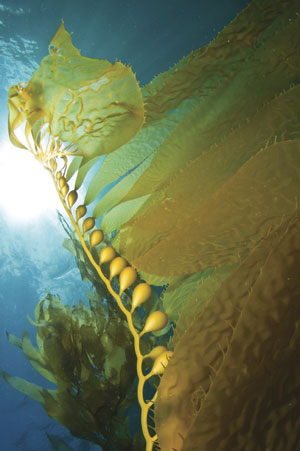BY EDWARD RICCIUTI

My first dive into a California kelp forest was eons ago, in the 1960s, with a team from the now-defunct Marineland of the Pacific, once the world’s largest oceanarium. A few hundred yards off the oceanarium on the Palos Verdes Peninsula, southwestern Los Angeles County, a school of garibaldi fish passed close enough to touch those on the formation’s margins. So-named because of their color – a brilliant red-orange that seems almost unnatural – the fish are a staple of the kelp forests that float along the Pacific margins of the U.S., from a depth of about 6 to 100 feet.
The fish reminded me of birds I’d seen so often flitting through the dark foliage of tropical rain forest vegetation. Indeed, the kelp forests parallel terrestrial forests in many ways.
Like rain forests on land, kelp forests are an extremely rich ecosystem, supporting a host of organisms from the minute, such as microscopic plants, to the mammoth, like gray whales. The kelp forest, like its counterparts on land, is ecologically layered with different communities from top to bottom. It has a sunlit canopy, a murky middle and a dark bottom.
The canopy, sometimes so thick that seabirds perch there, is made of the upper portions of brown kelp fronds floating on the surface by means of inflated gas bladders. On the bottom, the fronds are anchored by holdfasts, gripping rocks like gnarled fingers. Kelp are not true plants, but really giant brown algae, with a species called giant bladder kelp dominating from Central California south and bull kelp north of that.
To my mind, diving in a kelp forest is very much like walking through a tropical rain forest. Shafts of sunlight pierce gaps in the canopy like spotlights in the dark world below. Predators lurk in dark recesses of the undulating fronds. During my dive with Marineland, our eyes were peeled for a great white shark seen in the vicinity the day before. Life turns up unexpectedly in the kelp, like the spiny lobsters that crawl among holdfasts on the bottom and the sea urchins hidden in the folds of fronds. The sea urchins graze on the kelp and are held in check by sea otters, which find them as luscious as the urchins do kelp. When sea otters, still imperiled, were nearly hunted to extinction for their fur in the early 20th century, sea urchin populations exploded, chewing off kelp at the holdfast. Kelp beds almost vanished along with the otters, and along with them so did a myriad of other animals that depended on the beds for survival. For their role in controlling sea urchins, sea otters are considered a keystone species of the kelp forest.
Kelp forests grow along rocky coasts in waters that are nutrient-rich and cool, from about 42° F to 72° F. Warm water reduces the amount of dissolved inorganic nitrogen, which inhibits kelp growth. For this reason, Southern California kelp forests shrink in the heat of summer.
Both species of kelp (bull and giant) have a two-stage lifecycle, although bull kelp is an annual seaweed and giant kelp can take seven years to complete the cycle. Their first stage is as a tiny spore, released by a reproductive organ on the adult kelp called a sporophyte. The spores grow into a stage known as a gametophyte, which produces either sperm or eggs for fertilization. The embryo that results grows into a goliath of an alga. Giant kelp can grow at up to two feet per day, and bull kelp about four inches during the same amount of time.
Four national marine sanctuaries operated by the National Oceanic and Atmospheric Administration harbor magnificent kelp forests. Three are in California: the Channel Islands National Park, the Monterey Bay and the Gulf of Farallones National Marine Sanctuary. The Olympic Coast National Marine Sanctuary is in Washington State, off the Olympic Peninsula.
For the majority of people who do not don diving gear, kelp forest life can be seen in many public aquariums. One of the top kelp forest exhibits is in California’s Monterey Bay Aquarium, in the heart of kelp forest country. The exhibit features many of the creatures that call the kelp forest home. The rockfish have more than 100 species ranging in color from black to bright red. All have large eyes and mouths that seem frozen in a perpetual frown. Leopard sharks – despite their name they are docile and generally harmless to humans – teem in kelp forests. Attractively spotted, they reach a length of about four feet and are graceful swimmers. The plug-ugly of the kelp forest is the cabezon – the name is Spanish for “large head” – a bottom-dwelling sculpin with a mouth that enables it to swallow small abalones whole, after which it regurgitates the shell.
From the sea otters that like to float belly-up on the surface to the sculpins that prowl the bottom, the life of the kelp forest is all intertwined. If one strand comes undone, the entire forest may unravel. It provides one of the most dramatic examples of the interdependence of natural communities.
Edward Ricciuti has covered conservation issues around the globe. His specialties include natural history, environmental and conservation issues, science and law enforcement. He was a curator for the New York Zoological Society, now the Wildlife Conservation Society. He has written more than 80 books, with his most recent “The Snake Almanac” (The Lyons Press).
RESOURCES






